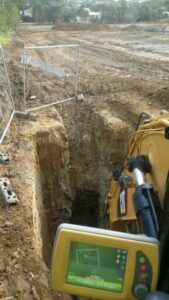Victorian-based Sure Constructions is a road and civil construction company servicing the greater Gippsland Area with locations in the west, south and far east.
Businesses Gippsland Pipelines (Sewer and Water infrastructure) and Stable Roads (Road Stabilisation) are both owned by Sure Constructions and are an integral part of the dynamic Sure group.
Associate Director and Director of Gippsland Pipelines Mark Steggall loves to explore the use of the latest technology to improve productivity, safety and efficiency.
Topcon GPS technology has been in the business for nine years with machine control being utilised for the last seven.

Recently, Mr Steggall and his colleagues used Topcon GPS technology to excavate two deep shafts over 6.5m in depth using a combination of linework and surface file to ensure the shaft was dug square and to depth using only the excavator and a single operator.
“We used the Topcon system to excavate two stormwater shafts for the Bass Coast Shire Council at our new estate in the beach-side township of Corinella, Victoria,” Mr Steggall said.
“Each shaft was four metres long by three metres wide and over six and a half metres deep. The shafts enabled our microtunneling team Edge Underground to commence drilling from downstream utilising our Topcon HiPer survey rover for setout. I even used an old Topcon Theodolite to assist with alignment,” he added.
The precision bore travelled over 150m through a hill – at times reaching depths of 9.5m below natural surface, Mr Steggall explained.
“The accuracy of the holes that we excavated using the GPS impressed me – and our drillers – who noted that it was great for them to be perfectly centralised at the bottom of the shaft with crushed rock spread at the correct height, unlike other experiences they have had,” he said.
“We excavated the holes to depth – testing the excavator GPS sensors to their limits – then bucketed rock into the bottom of the hole and even levelled the material before any shields were placed.
This was a marked improvement on previous methods whereby shields were often lowered in, depths checked, then shields removed to continue excavation and rock placement, followed by manual rock spreading, which can be tiresome work.
Mr Steggall’s team allowed 100 millimetres around the outside of the shields for the excavation and “the shields slipped in first time perfectly – vastly reducing the excavation time and rock backfill required
“It was a more efficient and productive method, not to mention a safer one as there was no need for anyone to stand near the edge of the pit and around working machinery to check the depth,” he said.
Enabling the Topcon system to complete the task required a combination of Mr Steggall’s engineering expertise and experience, and the technical know-how of Topcon’s Australian distributor Aptella and, of course, technology that was up to the task!
“My good mate Johnny-V from Aptella has been helping us for years and was instrumental in our implementation of this excavation method. He showed us latest ‘shovel bucket’ technology from a very recent firmware upgrade to dig the far face. Johnny has been great to us over the journey – helping from machine installs, technical advice and on the job training – he is my go-to person at Aptella.
“The results speak for themselves and I am very pleased with what we’ve achieved using this technology,” Mr Steggall said.
“We’ve always used Topcon and we have three full – time graders and three full-time excavators fitted with GPS and another four machines that are GPS-ready so we can switch the components around as required.
“We like the flexibility of being able to swap systems between machines, as well as the back-up of Aptella and some of the unique services they offer such as Tokara Link – which enables me to send design files straight to the machines from my office as well as login and troubleshoot with the operators,” he added.

We source, deploy and support intelligent positioning solutions to enhance our customers’ productivity.
Aptella Pty Ltd
ABN 56 130 367 065
2024 Aptella Pty Ltd | ABN 56 130 367 065 | Terms and Conditions | Privacy Policy